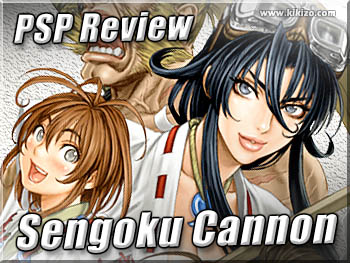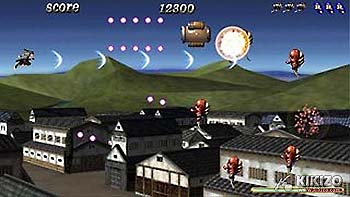Sengoku Cannon
Celestial warriors take to the skies once again, battling against an onslaught of airborne foes in the third chapter of Psikyo's Sengoku Ace series: Sengoku Cannon.
| Version PSP | Developer Psikyo | Publisher X-Nauts | Genre Shooter |
||||
Recently released in Japan, we received our import copy of Psikyo's first PSP shmup offering, and we've blown through the game again and again for this full review.

The original Sengoku Ace flew into Japanese arcades back in 1993, providing shooter fans with some vertically scrolling shooting action similar to that of Psikyo's later released Strikers 1945 series. Three years later, the sequel, Sengoku Ace Episode 2, landed in Japanese arcades, continuing the celestial samurai and shogun shooting theme but shifting the action to a side-scrolling viewpoint instead of remaining a vertically scrolling shooter like the original. A Sega Saturn port followed that same year.
Sengoku Cannon, the third chapter in the Sengoku Ace series, foregoes any sort of arcade presence and makes its debut on Sony's PSP. Continuing the horizontally scrolling shooting gameplay style of Sengoku Ace Episode 2, Sengoku Cannon makes somewhat of a decent outing on Sony's portable dream machine, but with rather less effectiveness compared to its predecessor.
The setting of Sengoku Cannon is once again the skies of ancient Japan where players can initially take control of one of four available warriors, with two additional playable characters becoming unlocked after completing the game.
Returning playable characters include, Koyori, the buxom heroine from Episode 2 who returns along with Ein, the totally cut n' ripped one-eyed samurai. New characters include Mizuka, your typically cutesy, high-pitched anime-styled female character with plenty of maneuverability and firepower. And last in the default character list is Masamitsu, a young swordsman who has set out on a personal mission.
Taking control of these airborne warriors, players will have to blast their way through 5 short levels, gunning down various types of enemies and dodging almost countless amounts of enemy fire along the way until reaching a series of boss characters dead set on impeding their progress.
Despite the high level of speed that most of the characters move around at, they all control quite well, which is to be expected from a Psikyo shooter, and each character differs slightly in terms of fire power and maneuverability. Utilizing the analog nub or d-pad, players can easily weave in and out of fields of enemy fire while dishing out some punishment of their own.
Your offensive capabilities consist of four firing types. There's an auto shot, which allows players to continuously fire their weapon by holding down the auto-shot button. The regular shot button can perform the same task by repeatedly tapping it, or you can hold it down to unleash more enhanced shots that are discharged continuously, but the trade-off is that it slows your character's maneuverability down in the process which can be both a good thing and a bad thing depending on the situation. By default, your regular and auto shots start off a bit underpowered, but can be enhanced by destroying certain enemies and picking up power-ups along the way.
A traditional bomb button serves as your super weapon of sorts and renders you temporarily invincible while in use to help get players out of some sticky situations as well as inflict more damage onto enemy swarms and bosses. And last but not least is the cannon shot, which is another powerful attack that can not only inflict significantly more damage onto enemies than your standard shots, but can also be used to rack up some nice bonus points - utilizing some sort of (as we like to refer to it as) damage-based scoring system that measures the amount of damage players inflicted onto the destroyed enemies with the cannon shot and rewards them with bonus points accordingly.
As far a game modes go, Sengoku Cannon doesn't offer much. There's the Story mode which is the main gameplay mode that allows players to plow through the game's handful of levels and read and listen to some character dialogue along the way. There's a Practice mode where you can select any of the available characters and select 1 of the 5 available levels to play through, there's also a Ranking mode where you can view your highest scores achieved in a particular level, as well as an Option mode which provides access to some very basic functions like remapping the button functions and such.
Sengoku Cannon provides an overall decent level of challenge. As players maneuver their characters over the skies of ancient Japan they'll encounter plenty of opposition in the form of various other kinds of enemy objects, creatures, ships, and even air ninjas among other things. However, while the levels themselves are easy to work through, the greatest challenges occur during the game's various boss encounters which occur multiple times in each level. There are four main boss character types and these bosses are no doubt tough little suckers that'll keep players in continuous motion, weaving in and out of wave upon wave of enemy fire. Some of the later boss encounters tend to get a little insane with screens literally filled with bullets and harmful orbs moving around in every direction with no safe spot in sight, making for a pretty frenetic twitch gaming experience at times.
But even with its quick-paced action and sometimes busy onscreen activity, Sengoku Cannon remains an average shooter at best, one that unfortunately comes up way short in the longevity department.
We managed to plow through the game in under 27 minutes, something I doubt many gamers will be willing to plunk down $50 clams for. On top of that, aside from the 2 unlockable characters, the game really offers nothing in the way of extras or any type Wi-Fi functionality for matter, which is a bit disheartening especially with a game that was seemingly designed for the PSP.
Graphically, Sengoku Cannon looks OK for a traditional 2D styled shooter, but looks pretty bad as a PSP offering and is plagued with graphical problems in various forms. For starters there's slowdown when there's a bit of onscreen activity going on and the slowdown hits INSANE levels during the last level, which at times brings the PSP to a Super NES-like crawl, an experience somewhat similar to playing Super R-type on the Super NES.
The backgrounds however are the main reason for the game's below average visuals. There are some truly awful background graphics here, and once you get past the game's decent looking first level with 3D background structures and landscapes zipping by at speedy rates with plenty of scaling and rotation effects applied, the backgrounds in the levels that follow just take a complete nosedive. It's obvious that the developers pretty much stopped caring after completing their design of the first stage. Most of the later levels are plagued with bad transitions and are riddled glitches such as screen flicker, noticeable tearing, and overall just look like sloppily tacked on after thoughts.
The most appealing aspect of the game's graphics are the cool anime-styled character designs provided by Jun Tsukasa, the series' artist whose had a number of published works, but sadly his talents were obviously wasted here. The game also has some load times but they're an easily digestible 12-14 seconds before the start of every level which isn't too bad compared to a lot of other games released for the unit.
The sound department of Sengoku Cannon certainly seems to fare better than the graphics, sporting some adventure-ish sounding orchestrated BGM tracks that, while nothing special or memorable on their own, fit the action well. The sound effects are solid as well with various types of explosions, and cutesy Japanese voice samples. The game also contains some speech as well, all of which sound pretty decent.
Overall, While Sengoku Cannon isn't the PSP's first shooter, it has the honor of being the first horizontal scrolling shooter released for the unit and is a bit of a disappointment considering the game's potential. A variety of items could have used more work, and judging by the short staff listing in the credits screen, more resources and man-power as well.
The addition of any kind of Wi-Fi multiplayer or connectivity features could have certainly upped the game's appeal maybe a little, but as is, this game's pretty much a lost cause and is about as basic in its feature set as PSP games can get.
While I've personally found some enjoyment in the game, the flaws are just too great to ever recommend it as a purchase. Check out the recently released Star Soldier instead, it's a vertically scrolling shooter but you can also play horizontally and overall just feels much more rewarding, with twice as many levels, bonus extras, and Wi-Fi functionality.
| ||||||||||||
|










 Satoru Iwata Video Interview - the late Nintendo president spoke with Kikizo in 2004 as 'Nintendo Revolution' loomed.
Satoru Iwata Video Interview - the late Nintendo president spoke with Kikizo in 2004 as 'Nintendo Revolution' loomed. Kaz Hirai Video Interview - the first of Kikizo's interviews with the man who went on to become global head of Sony.
Kaz Hirai Video Interview - the first of Kikizo's interviews with the man who went on to become global head of Sony. Ed Fries Video Interview - one of Xbox's founders discusses an epic journey from Excel to Xbox.
Ed Fries Video Interview - one of Xbox's founders discusses an epic journey from Excel to Xbox. Yu Suzuki, the Kikizo Interview - we spend time with one of gaming's most revered creators.
Yu Suzuki, the Kikizo Interview - we spend time with one of gaming's most revered creators. Tetris - The Making of an Icon: Alexey Pajitnov and Henk Rogers reveal the fascinating story behind Tetris
Tetris - The Making of an Icon: Alexey Pajitnov and Henk Rogers reveal the fascinating story behind Tetris Rare founders, Chris and Tim Stamper - their only interview? Genuinely 'rare' sit down with founders of the legendary studio.
Rare founders, Chris and Tim Stamper - their only interview? Genuinely 'rare' sit down with founders of the legendary studio. The History of First-Person Shooters - a retrospective, from Maze War to Modern Warfare
The History of First-Person Shooters - a retrospective, from Maze War to Modern Warfare